

Compact Muon Solenoid
LHC, CERN
| CMS-HIN-15-003 ; CERN-EP-2016-039 | ||
| ${\Upsilon\mathrm{(nS)}}$ polarizations versus particle multiplicity in pp collisions at $\sqrt{s} =$ 7 TeV | ||
| CMS Collaboration | ||
| 9 March 2016 | ||
| Phys. Lett. B 761 (2016) 31 | ||
| Abstract: The polarizations of the ${\Upsilon\mathrm{(1S)}} $, ${\Upsilon\mathrm{(2S)}} $, and ${\Upsilon\mathrm{(3S)}} $ mesons are measured as a function of the charged particle multiplicity in proton-proton collisions at $\sqrt{s} = $ 7 TeV. The measurements are performed with a dimuon data sample collected in 2011 by the CMS experiment, corresponding to an integrated luminosity of 4.9 fb$^{-1}$. The results are extracted from the dimuon decay angular distributions, in two ranges of ${\Upsilon\mathrm{(nS)}}$ transverse momentum (10-15 and 15-35 GeV), and in the rapidity interval $ | y | < 1.2 $. The results do not show significant changes from low- to high-multiplicity pp collisions, although large uncertainties preclude definite statements in the ${\Upsilon\mathrm{(2S)}} $ and ${\Upsilon\mathrm{(3S)}} $ cases. | ||
| Links: e-print arXiv:1603.02913 [hep-ex] (PDF) ; CDS record ; inSPIRE record ; HepData record ; CADI line (restricted) ; | ||
| Figures | |

png pdf |
Figure 1:
Charged particle multiplicity distribution of the events selected for the analysis. |
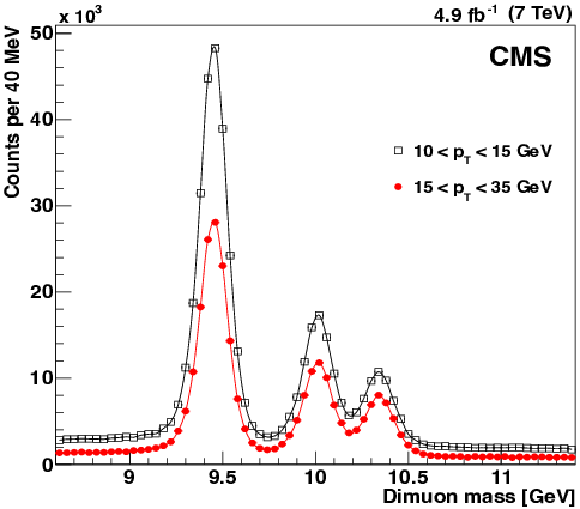
png pdf |
Figure 2:
Dimuon mass distributions in the ${\Upsilon \mathrm {(nS)}}$ region for two ${p_{\mathrm {T}}}$ ranges. |

png pdf |
Figure 3:
Distributions of $ {\cos\vartheta } $ (left) and $\varphi $ (right), for the ${\Upsilon \mathrm {(2S)}}$ in a representative analysis bin. The curves represent two polarization scenarios (dashed and dotted lines, defined in the legends) and the measured case (solid lines: $ {\lambda _{\vartheta }} = 0.237$, $ {\lambda _{\varphi }} = -0.027$, $ {\lambda _{\vartheta \varphi }} = -0.025$). |

png pdf |
Figure 3-a:
Distribution of $ {\cos\vartheta } $, for the ${\Upsilon \mathrm {(2S)}}$ in a representative analysis bin. The curves represent two polarization scenarios (dashed and dotted lines, defined in the legends) and the measured case (solid lines: $ {\lambda _{\vartheta }} = 0.237$, $ {\lambda _{\varphi }} = -0.027$, $ {\lambda _{\vartheta \varphi }} = -0.025$). |

png pdf |
Figure 3-b:
Distribution of $\varphi $, for the ${\Upsilon \mathrm {(2S)}}$ in a representative analysis bin. The curves represent two polarization scenarios (dashed and dotted lines, defined in the legends) and the measured case (solid lines: $ {\lambda _{\vartheta }} = 0.237$, $ {\lambda _{\varphi }} = -0.027$, $ {\lambda _{\vartheta \varphi }} = -0.025$). |
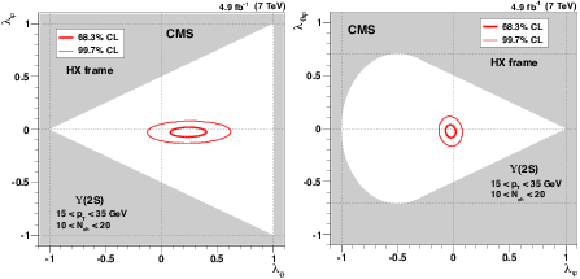
png pdf |
Figure 4:
Two-dimensional marginals of the PPD for the HX frame in the ${\lambda _{\varphi }}$ vs. $ {\lambda _{\vartheta }}$ (left) and ${\lambda _{\vartheta \varphi }}$ vs. $ {\lambda _{\varphi }}$ (right) planes, for ${\Upsilon \mathrm {(2S)}}$ with 15 $ < {p_{\mathrm {T}}} < $ 35 GeV and 10 $ < {N_\text {ch}} < $ 20, displaying the 68.3% and 99.7% CL total uncertainties. The shaded areas represent physically forbidden regions of parameter space for the decay of a $J=$ 1 particle [14]. |
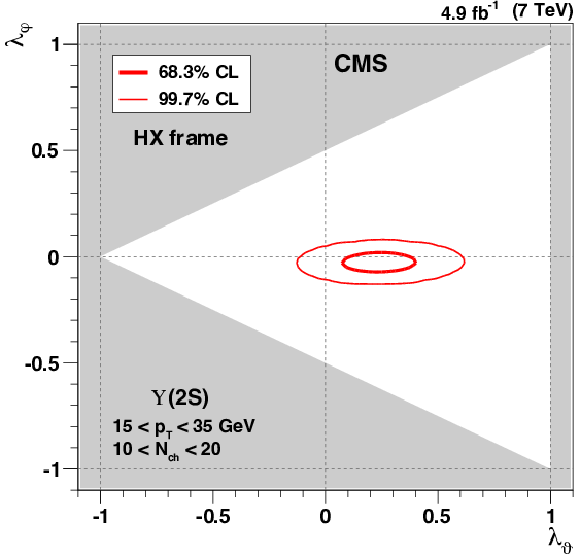
png pdf |
Figure 4-a:
Two-dimensional marginals of the PPD for the HX frame in the ${\lambda _{\varphi }}$ vs. $ {\lambda _{\vartheta }}$ plane, for ${\Upsilon \mathrm {(2S)}}$ with 15 $ < {p_{\mathrm {T}}} < $ 35 GeV and 10 $ < {N_\text {ch}} < $ 20, displaying the 68.3% and 99.7% CL total uncertainties. The shaded areas represent physically forbidden regions of parameter space for the decay of a $J=$ 1 particle [14]. |
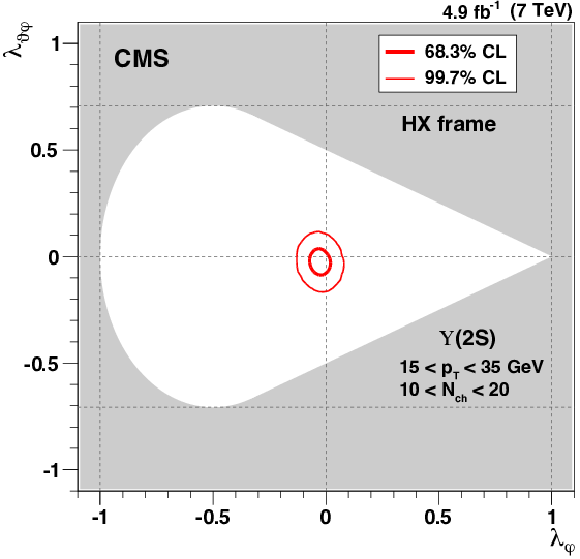
png pdf |
Figure 4-b:
Two-dimensional marginals of the PPD for the HX frame in the ${\lambda _{\vartheta \varphi }}$ vs. $ {\lambda _{\varphi }}$ (right) plane, for ${\Upsilon \mathrm {(2S)}}$ with 15 $ < {p_{\mathrm {T}}} < $ 35 GeV and 10 $ < {N_\text {ch}} < $ 20, displaying the 68.3% and 99.7% CL total uncertainties. The shaded areas represent physically forbidden regions of parameter space for the decay of a $J=$ 1 particle [14]. |
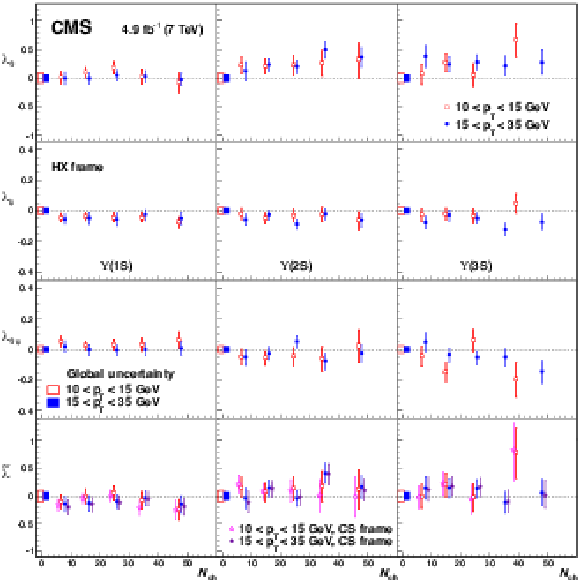
png pdf |
Figure 5:
The ${\lambda _{\vartheta }} $, ${\lambda _{\varphi }} $, ${\lambda _{\vartheta \varphi }} $, and ${\tilde{\lambda }}$ parameters (top to bottom) for the ${\Upsilon \mathrm {(1S)}} $, ${\Upsilon \mathrm {(2S)}} $, and ${\Upsilon \mathrm {(3S)}}$ states (left to right), in the HX frame, as a function of ${N_\text {ch}} $, for both ${p_{\mathrm {T}}}$ ranges. The ${\tilde{\lambda }}$ values are also shown for the CS frame; the HX and CS uncertainties are strongly correlated. The vertical bars represent the ${N_\text {ch}} $-dependent total uncertainties (at 68.3% CL), while the boxes at the zero horizontal line represent the global uncertainties. The points are placed at the average ${N_\text {ch}}$ of each bin, with a small offset for easier viewing. |

png pdf |
Figure 6:
Expected ${N_\text {ch}} $-dependences of the ${\lambda _{\vartheta }}$ parameter for the sum of two processes, of polarizations $\lambda _0$ and $\lambda _1$, of relative fractions changing linearly with ${N_\text {ch}}$ (see text for details). The measured ${\lambda _{\vartheta }}$ values are also shown, for the ${\Upsilon \mathrm {(3S)}}$ (left) and ${\Upsilon \mathrm {(1S)}}$ (right). |

png pdf |
Figure 6-a:
Expected ${N_\text {ch}} $-dependences of the ${\lambda _{\vartheta }}$ parameter for the sum of two processes, of polarizations $\lambda _0$ and $\lambda _1$, of relative fractions changing linearly with ${N_\text {ch}}$ (see text for details). The measured ${\lambda _{\vartheta }}$ values are also shown for the ${\Upsilon \mathrm {(3S)}}$. |

png pdf |
Figure 6-b:
Expected ${N_\text {ch}} $-dependences of the ${\lambda _{\vartheta }}$ parameter for the sum of two processes, of polarizations $\lambda _0$ and $\lambda _1$, of relative fractions changing linearly with ${N_\text {ch}}$ (see text for details). The measured ${\lambda _{\vartheta }}$ values are also shown for the ${\Upsilon \mathrm {(1S)}}$. |
| Tables | |

png pdf |
Table 1:
Signal yields, $N$, and background fractions, ${f_\text {Bg}}$ (in%), within 1$\sigma $ windows around the nominal ${\Upsilon \mathrm {(nS)}}$ masses for the considered ${N_\text {ch}}$ and ${p_{\mathrm {T}}}$ ranges. |

png pdf |
Table 2:
${\Upsilon \mathrm {(nS)}}$ polarization parameters in the HX frame. The global uncertainties, independent of state and ${N_\text {ch}} $ bin, are also indicated. |
| Summary |
| The polarizations of the ${\Upsilon\mathrm{(1S)}} $, ${\Upsilon\mathrm{(2S)}} $, and ${\Upsilon\mathrm{(3S)}} $ mesons produced in pp collisions at $\sqrt{s} = $ 7 TeV have been determined as functions of the charged particle multiplicity of the event in two ${\Upsilon\mathrm{(nS)}}$ $ p_{\mathrm{T}}$ ranges. The measurements do not show significant variations as a function of ${N_\text{ch}} $, even though the large ${\Upsilon\mathrm{(2S)}} $ and ${\Upsilon\mathrm{(3S)}} $ uncertainties preclude definite statements in these cases. This study opens the way for analogous measurements extending to the charmonium family, particularly interesting for the $\psi \mathrm{(2S)} $, which is unaffected by feed-down decays and, therefore, provides a more direct probe of LDME universality. Equivalent analyses should also be performed in pPb and PbPb event samples, in view of evaluating how quark-antiquark bound-state formation is influenced by the surrounding medium, which is an essential input for the interpretation of quarkonium suppression patterns in nuclear collisions. |
| References | ||||
| 1 | N. Brambilla et al. | Heavy quarkonium: progress, puzzles, and opportunities | EPJC 71 (2011) 1534 | 1010.5827 |
| 2 | G. Bodwin, E. Braaten, and P. Lepage | Rigorous QCD analysis of inclusive annihilation and production of heavy quarkonium | PRD 51 (1995) 1125 | hep-ph/9407339 |
| 3 | M. Butenschon and B. Kniehl | $ \mathrm{J}/\psi $ polarization at Tevatron and LHC: NRQCD factorization at the crossroads | PRL 108 (2012) 172002 | 1201.1872 |
| 4 | B. Gong, L.-P. Wan, J.-X. Wang, and H.-F. Zhang | Polarization for prompt $ \mathrm{J}/\psi, $ $ \psi $(2S) production at the Tevatron and LHC | PRL 110 (2013) 042002 | 1205.6682 |
| 5 | K.-T. Chao et al. | $ \mathrm{J}/\psi $ polarization at hadron colliders in NRQCD | PRL 108 (2012) 242004 | 1201.2675 |
| 6 | B. Gong, L.-P. Wan, J.-X. Wang, and H.-F. Zhang | Complete next-to-leading-order study on the yield and polarization of $ \Upsilon $(1S,2S,3S) at the Tevatron and LHC | PRL 112 (2014) 032001 | 1305.0748 |
| 7 | P. Faccioli et al. | Quarkonium production in the LHC era: a polarized perspective | PLB 736 (2014) 98 | 1403.3970 |
| 8 | CMS Collaboration | Observation of sequential $ \Upsilon $ suppression in PbPb collisions | PRL 109 (2012) 222301 | CMS-HIN-11-011 1208.2826 |
| 9 | T. Matsui and H. Satz | $ \mathrm{J}/\psi\ $ suppression by Quark-Gluon Plasma formation | PLB 178 (1986) 416 | |
| 10 | F. Karsch, D. Kharzeev, and H. Satz | Sequential charmonium dissociation | PLB 637 (2006) 75 | hep-ph/0512239 |
| 11 | A. Andronic et al. | Heavy-flavour and quarkonium production in the LHC era: from proton-proton to heavy-ion collisions | EPJC 76 (2015) 107 | 1506.03981 |
| 12 | CMS Collaboration | Event activity dependence of Y(nS) production in $ \sqrt{s_{NN}} = 5.02 $$ TeV $ pPb and $ \sqrt{s} = 2.76 $$ TeV $ pp collisions | JHEP 04 (2014) 103 | CMS-HIN-13-003 1312.6300 |
| 13 | CMS Collaboration | Measurement of the $ \Upsilon $(1S), $ \Upsilon $(2S), and $ \Upsilon $(3S) polarizations in pp collisions at $ \sqrt{s} = 7 $$ \,TeV $ | PRL 110 (2013) 081802 | CMS-BPH-11-023 1209.2922 |
| 14 | P. Faccioli, C. Lourenco, J. Seixas, and H. Wohri | Model-independent constraints on the shape parameters of dilepton angular distributions | PRD 83 (2011) 056008 | 1102.3946 |
| 15 | P. Faccioli, C. Lourenco, and J. Seixas | Rotation-invariant relations in vector meson decays into fermion pairs | PRL 105 (2010) 061601 | 1005.2601 |
| 16 | P. Faccioli, C. Lourenco, J. Seixas, and H. Wohri | Towards the experimental clarification of quarkonium polarization | EPJC 69 (2010) 657 | 1006.2738 |
| 17 | CMS Collaboration | Measurement of the prompt $ \mathrm{J}/\psi\ $ and $ \psi $(2S) polarizations in pp collisions at $ \sqrt{s} = 7 $$ \,TeV $ | PLB 727 (2013) 381 | CMS-BPH-13-003 1307.6070 |
| 18 | CMS Collaboration | The CMS experiment at the CERN LHC | JINST 3 (2008) S08004 | CMS-00-001 |
| 19 | CMS Collaboration | Description and performance of track and primary-vertex reconstruction with the CMS tracker | JINST 9 (2014) P10009 | CMS-TRK-11-001 1405.6569 |
| 20 | M. J. Oreglia | A study of the reactions $\psi' \to \gamma\gamma \psi$ | PhD thesis, Stanford University, 1980 SLAC-R-236 | |
| 21 | CMS Collaboration | Measurements of inclusive W and Z cross sections in pp collisions at $ \sqrt{s} = 7 $$ \,TeV $ | JHEP 01 (2011) 080 | |
| 22 | J. Collins and D. Soper | Angular Distribution of Dileptons in High-Energy Hadron Collisions | PRD 16 (1977) 2219 | |
| 23 | E. Braaten, D. Kang, J. Lee, and C. Yu | Optimal spin quantization axes for the polarization of dileptons with large transverse momentum | PRD 79 (2009) 014025 | 0810.4506 |
| 24 | P. Faccioli, C. Lourenco, and J. Seixas | New approach to quarkonium polarization studies | PRD 81 (2010) 111502(R) | 1005.2855 |
| 25 | P. Faccioli, C. Lourenco, J. Seixas, and H. Wohri | Determination of $ \chi_c $ and $ \chi_b $ polarizations from dilepton angular distributions in radiative decays | PRD 83 (2011) 096001 | 1103.4882 |

|
Compact Muon Solenoid LHC, CERN |

|

|

|

|

|

|